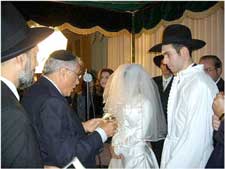There is a saying that if you help three couples get married, you're guaranteed a spot in the next world. At the very least you will definitely be invited to their weddings. If you've never been to an Orthodox wedding, consider yourself forewarned: When men learn that the bride can't shake hands, a few commonly make the mistake of leaning over and kissing the bride instead. Don't let that happen to you! If touching is bad, kissing is worse. But there is usually lots of food available to compensate for not being able to touch the bride.
Before the ceremony, the groom is preceded by a retinue of singing and dancing friends, and escorted in the arms of his father and future father-in-law all the way to his bride. There he lowers a veil over his bride's face, an indication that his attraction to her is not superficial. It further signals the groom's commitment to take care of his wife, but this was formally established earlier in the day, when he signed a document detailing even her sexual rights. (The traditional Jewish wedding may be romantic, but it is also extremely practical.)
 As the seven blessings are pronounced during the wedding ceremony, you may notice that the bride and groom aren't wearing any jewelry, a sign that they are marrying each other for who they are alone. Like the Eskimos, who have many words for snow, Jews have ten distinct Hebrew words for joy, and the bride and groom are blessed so that they may feel all of them together.
As the seven blessings are pronounced during the wedding ceremony, you may notice that the bride and groom aren't wearing any jewelry, a sign that they are marrying each other for who they are alone. Like the Eskimos, who have many words for snow, Jews have ten distinct Hebrew words for joy, and the bride and groom are blessed so that they may feel all of them together.
There is one sentence you will never hear at a traditional Jewish wedding, and that is, "You may now kiss the bride." Instead, the new husband and wife retire for about ten minutes alone. Usually the couple eats and catches their breath, but going to a private room is significant because it's the first time that the bride and groom are allowed to be totally alone with each other. A friend of the groom's actually stands guard at the door to make sure that the couple really gets this time.
When the bridal couple pops out, everyone dances, even if they came to the wedding all by themselves. That's because all the women dance with the bride and the men with the groom. Friends usually stage little performances to make the couple laugh. This tradition dates from before Talmudic times.
Reprinted with permission from incharacter.org.
Wendy Shalit was born in Milwaukee, Wisconsin, and received her Bachelor of Arts in Philosophy from Williams College in 1997.
Her essays have appeared in Commentary, Slate, the Wall Street Journal, and other publications. Her first book, A Return to Modesty: Discovering the Lost Virtue, was published by the Free Press in 1999. Her second book, The Good Girl Revolution, was released in 2007.
The response from young women around the world prompted her to launch the group blog ModestlyYours.net, an online forum for women who don't have a voice in the mainstream media.
Wendy lives with her husband and son in Toronto, Ontario, where she enjoys various modern appliances such as the dishwasher, and has no desire to return to the 19th century.




